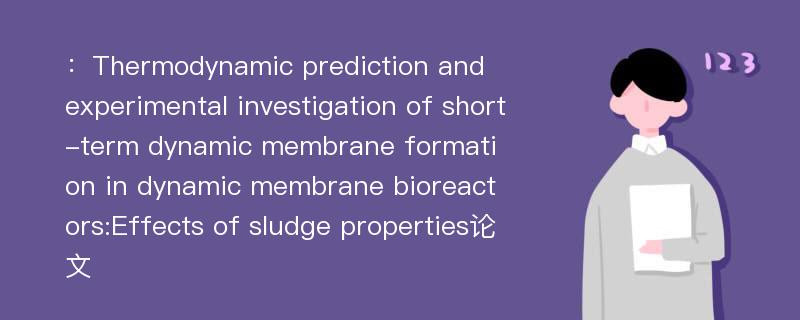
本文主要研究内容
作者(2019)在《Thermodynamic prediction and experimental investigation of short-term dynamic membrane formation in dynamic membrane bioreactors:Effects of sludge properties》一文中研究指出:In dynamic membrane bioreactors(DMBRs), a dynamic membrane(DM) forms on a support material to act as the separation membrane for solids and liquids. In this study, batch filtration tests were carried out in a DMBR using nylon mesh(25 μm) as support material to filtrate sludge suspensions of variable properties from three different sources to evaluate the effects on the short-term DM formation process(within 240 min). Furthermore, the extended Derjaguin–Landau–Verwey–Overbeek(XDLVO) theory was applied to analyze the sludge adhesion and cohesion behaviors on the mesh surface to predict quantitative parameters of the short-term DM formation process(including initial formation and maturation stage). The filtration results showed that the order of the initial DM formation time(permeate turbidity <1 NTU as an indicator) was as follows: sludge with poor settleability and dewaterability < normal sludge <sludge with poor flocculability. Moreover, normal sludge(regarding settleability, dewaterability,flocculability, and extracellular polymeric substance) showed a more acceptable DM formation performance(short DM formation time, low permeate turbidity, and high permeate flux) than sludge with poor settleability, dewaterability and flocculability. The influence of sludge properties on the initial DM formation time corroborates the prediction of sludge adhesion behaviors by XDLVO theory. Additionally, the XDLVO calculation results showed that acid–based interaction, energy barrier, and secondary energy minimum were important determinants of the sludge adhesion and cohesion behaviors. Therefore, short-term DM formation process may be enhanced to achieve stable long-term DMBR operation through positive modification of the sludge properties.
Abstract
In dynamic membrane bioreactors(DMBRs), a dynamic membrane(DM) forms on a support material to act as the separation membrane for solids and liquids. In this study, batch filtration tests were carried out in a DMBR using nylon mesh(25 μm) as support material to filtrate sludge suspensions of variable properties from three different sources to evaluate the effects on the short-term DM formation process(within 240 min). Furthermore, the extended Derjaguin–Landau–Verwey–Overbeek(XDLVO) theory was applied to analyze the sludge adhesion and cohesion behaviors on the mesh surface to predict quantitative parameters of the short-term DM formation process(including initial formation and maturation stage). The filtration results showed that the order of the initial DM formation time(permeate turbidity <1 NTU as an indicator) was as follows: sludge with poor settleability and dewaterability < normal sludge <sludge with poor flocculability. Moreover, normal sludge(regarding settleability, dewaterability,flocculability, and extracellular polymeric substance) showed a more acceptable DM formation performance(short DM formation time, low permeate turbidity, and high permeate flux) than sludge with poor settleability, dewaterability and flocculability. The influence of sludge properties on the initial DM formation time corroborates the prediction of sludge adhesion behaviors by XDLVO theory. Additionally, the XDLVO calculation results showed that acid–based interaction, energy barrier, and secondary energy minimum were important determinants of the sludge adhesion and cohesion behaviors. Therefore, short-term DM formation process may be enhanced to achieve stable long-term DMBR operation through positive modification of the sludge properties.
论文参考文献
论文详细介绍
论文作者分别是来自Journal of Environmental Sciences的,发表于刊物Journal of Environmental Sciences2019年03期论文,是一篇关于,Journal of Environmental Sciences2019年03期论文的文章。本文可供学术参考使用,各位学者可以免费参考阅读下载,文章观点不代表本站观点,资料来自Journal of Environmental Sciences2019年03期论文网站,若本站收录的文献无意侵犯了您的著作版权,请联系我们删除。
